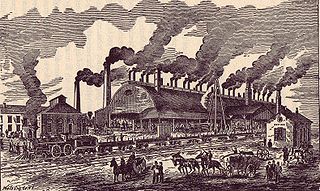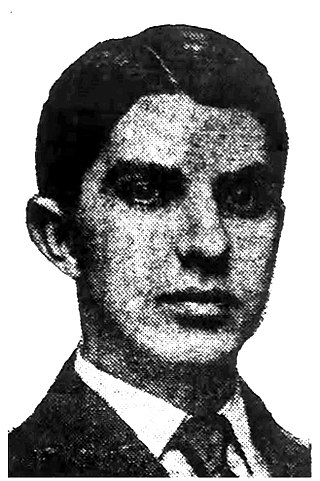
Roswell is a city in northern Fulton County, Georgia, United States. At the official 2020 census, the city had a population of 92,883, making Roswell the state's ninth largest city. A suburb of Atlanta, Roswell has an affluent historic district.

"Fiddlin'" John Carson was an American musician and singer who is widely considered to be one of the early pioneers of country music.
There were several historic mills around the metro Atlanta area, for which many of its current-day roads are still named. Most of the mills date back to the 1820s and 1830s, and were built along the area's many streams. The locations of many of these mills are shown on a map of 1875 showing U. S. military operations around Atlanta in 1864. This map is now located in the U. S. Library of Congress but can be seen on the webpage linked here.

The Atlanta Rolling Mill was constructed in 1858 by Lewis Schofield and James Blake and soon after, Schofield and William Markham took it over and transformed it into the South's second most productive rolling mill, after the Tredegar Iron Works in Richmond, Virginia.

Cabbagetown is an intown neighborhood on the east side of Atlanta, Georgia, United States, abutting historic Oakland Cemetery. It includes the Cabbagetown District, a historic district listed on the U.S. National Register of Historic Places.

Located at 695 North Avenue in Atlanta, the Dupre Excelsior Mill may have been built as early as 1890 by DuPre Manufacturing Company. However, the mill fails to appear on Atlanta city maps in 1892 and 1899, which both show the property as vacant. The first possible reference to the mill exists in the report of the death of Hubert Neal on July 17, 1899. According to the report, his accident occurred at the Atlanta Excelsior Works, which may or may not be the same facility since at the time there were three excelsior factories in Atlanta. The earliest concrete confirmation of the mill seems to be three lawsuits filed against Dupre in 1907 for accidents that occurred at the facility. The mill does appear on the Sanborn-Perris fire insurance map of 1911. At that time, the only road connecting it was Angier Street. It was noted to have been heated by steam power, no lighting, and a private water supply from a well 10 feet in diameter and 40 feet deep. A watchman made hourly rounds to seven stations.

Young Frank Freeman was studio head at Paramount Pictures from 1938 to 1959. Freeman was born in Greenville, Georgia, as the second child and first son of Young Frank Freeman Senior, a cotton farmer and merchant. He graduated from the Georgia Institute of Technology in 1910. In addition to his work with Paramount, he also worked in the fields of banking, real estate, higher education, and athletics.

Isaac Stiles Hopkins was a professor and the first President of the Georgia Institute of Technology (1888–1896) as well as pastor of the First Methodist Church in Atlanta, Georgia.

The Georgia Tech Alumni Association is the official alumni association for the Georgia Institute of Technology. Originally known as the Georgia Tech National Alumni Association, it was chartered in June 1908 and incorporated in 1947. Its offices have been in the L. W. "Chip" Robert, Jr. Alumni House on North Avenue since 1979.

The Atlanta Biltmore Hotel and Biltmore Apartments is a historic building located in Atlanta, Georgia. The complex, originally consisting of a hotel and apartments, was developed by William Candler, son of Coca-Cola executive Asa Candler, with Holland Ball Judkins and John McEntee Bowman. The original hotel building was converted to an office building in 1999. The building is currently owned by the Georgia Institute of Technology and is adjacent to Technology Square.

The Everett Mills are a group of buildings consisting of the Everett and Stone Mills in Lawrence, Massachusetts. A former cotton textile mill, it was the site of the start of the Bread and Roses strike in 1912 and the one time workplace of Robert Frost.
Marietta Street Artery is an officially defined neighborhood of the city of Atlanta, Georgia, part of the West Midtown area of Atlanta, also known as the "Westside."

Ola Delight Lloyd Smith was an American telegrapher, journalist, and labor activist.

Hentz, Reid & Adler was an architectural firm that did work in the U.S. state of Georgia. The firm is "known in the Southeast for their Beaux-Arts style and as the founding fathers of the Georgia school of classicism."

The main campus of the Georgia Institute of Technology occupies part of Midtown Atlanta, primarily bordered by 10th Street to the north, North Avenue to the south, and, with the exception of Tech Square, the Downtown Connector to the East, placing it well in sight of the Atlanta skyline. In 1996, the campus was the site of the athletes' village and a venue for a number of athletic events for the 1996 Summer Olympics. The construction of the Olympic Village, along with subsequent gentrification of the surrounding areas, significantly changed the campus.
The following is a timeline of the history of the city of Atlanta, Georgia, United States.
The United Textile Workers of America (UTW) was a North American trade union established in 1901.

Frank Henry Neely was an American mechanical engineer, consulting engineer, and President of Rich's Department Store in Atlanta. He is known for his civic activities in Atlanta, and as recipient of the Henry Laurence Gantt Medal in 1952.
The 1914–1915 Fulton Bag and Cotton Mills strike was a labor strike involving several hundred textile workers from the Fulton Bag and Cotton Mills in Atlanta, Georgia, United States. The strike, which involved about 500 millworkers, began on May 20, 1914, and ended almost a year later on May 15, 1915, in failure for the strikers.

















